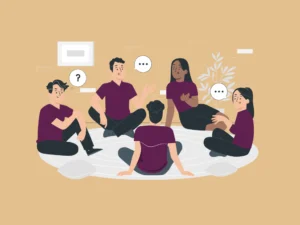Trust and respect form the core architecture of any therapeutic relationship. Without these foundational elements, even the most sophisticated therapeutic approaches will fall short. Trust allows clients to feel emotionally safe, while respect honors their autonomy, identity, and lived experience. These are not simply nice-to-haves—they are non-negotiables for meaningful therapeutic work. Whether therapy is brief or long-term, cognitive or experiential, it will only reach its potential when built on the stable ground of mutual trust and deep respect. This guide explores how trust and respect operate in therapy, how they are built and maintained, and what therapists can do when these vital connections are strained or broken.
Trust in the Therapeutic Relationship
Trust in the therapeutic relationship is not given automatically—it is earned through consistent, attuned, and ethical engagement. Clients are often entering therapy in vulnerable states, sometimes after experiencing betrayal, neglect, or judgment in other relationships. Trust means the client believes that the therapist will not harm, exploit, or dismiss them. It means they feel emotionally held and free to express themselves without fear. Trust is not merely about believing that the therapist is competent—it’s also about believing that they care (Finsrud et al., 2022.) Over time, trust becomes the invisible but felt presence in the room, allowing deeper emotional and psychological exploration.
Importance of Trust in Therapeutic Relationships
The importance of trust in therapy cannot be overstated. When clients trust their therapist, they are more likely to disclose sensitive thoughts, take emotional risks, and be honest about their challenges. This transparency is essential for therapy to be effective. Trust also helps clients internalize the therapeutic process—they begin to develop a sense of safety that can extend beyond the therapy room. This is particularly crucial for clients with trauma histories, for whom trust may feel foreign or dangerous. In essence, trust is what allows the work of therapy to begin and what sustains it through the inevitable complexities that follow (Morera-Balaguer, 2021.)
How to Build Trust in the Therapeutic Relationship
Building trust in therapy is a deliberate, ongoing process. It starts with small moments of attunement—remembering a detail from a previous session, acknowledging a client’s courage, or maintaining consistent boundaries. Therapists can build trust by being reliable, emotionally present, and transparent about their role. Phrases like “You don’t have to share anything you’re not ready to” or “We’ll go at your pace” help establish psychological safety. Validating a client’s experience—even when it’s painful or complicated—also builds trust. Over time, these gestures create a relational fabric strong enough to hold even the most difficult therapeutic work (Geller, 2023.)
Broken Trust in the Therapeutic Relationship
Even in the most intentional relationships, trust can be broken. Misattunements, misunderstandings, or perceived judgment can rupture the therapeutic alliance. For many clients, especially those with trauma or attachment wounds, even a small misstep can feel like a major betrayal. When trust is broken, it’s essential that the therapist take the lead in naming the rupture and inviting repair. Avoiding the topic or becoming defensive only deepens the damage. Instead, the therapist might say, “I noticed you seemed distant after our last session—did something feel off?” When handled with care, ruptures can become opportunities for deeper trust, demonstrating that conflict doesn’t have to mean disconnection or abandonment.
Respect in the Therapeutic Relationship
Respect in therapy means honoring the client’s voice, choices, identity, and pace. It involves recognizing that the client is the expert on their own life, even when they feel uncertain or lost. Respect shows up in how therapists use language, how they handle disagreement, and how they respond to a client’s boundaries. It’s the opposite of pathologizing or fixing—it’s about being with someone in their struggle without taking their agency away. Respect also includes cultural humility, trauma-informed practice, and an awareness of power dynamics (Forchuk, 2022.) When clients feel respected, they feel empowered to explore, question, and grow without fear of judgment or coercion.
Trust and Respect as Interdependent Forces
While trust and respect are distinct, they are deeply interconnected. Trust without respect can feel patronizing or coercive, while respect without trust can feel hollow or superficial. When both are present, a powerful relational synergy emerges: clients feel safe and seen. They know their therapist is not only reliable but also deeply honoring of their humanity. This dual presence allows for emotional risk-taking, deep exploration, and authentic change. For therapists, cultivating both trust and respect means constantly reflecting on their words, tone, actions, and presence. It’s about showing up not as an expert who knows best, but as a collaborator who listens and learns.
The Role of Boundaries in Building Trust and Respect
Boundaries are a form of care, and in therapy, they are essential for maintaining trust and respect. A therapist who holds clear, consistent boundaries is signaling, “This space is safe, structured, and focused on you.” Boundaries prevent enmeshment and confusion, making the relationship more predictable and trustworthy. They also respect the client’s autonomy—by not overreaching, rescuing, or reacting impulsively, the therapist allows the client to lead their process. Whether it’s ending sessions on time, managing dual relationships, or handling disclosures with care, boundary clarity supports both emotional security and mutual respect.
Cultural Responsiveness and Respect
Respect cannot be separated from cultural responsiveness. Clients come into therapy shaped by race, class, gender, sexuality, religion, ability, and other cultural factors that deeply impact their lived experiences. A respectful therapist does not minimize or ignore these identities—they actively seek to understand them. This might include acknowledging systemic oppression, being mindful of microaggressions, and being open to feedback about blind spots. Cultural respect also means using inclusive language, checking assumptions, and co-creating a therapeutic space that affirms rather than erases the client’s identity (Scott, 2025.) When done well, it reinforces the therapist’s respect not just for the client’s story, but for their full humanity.
Client Autonomy and the Practice of Respect
Respecting client autonomy means recognizing that therapy is not about fixing or directing—it’s about walking alongside. Clients must be free to define their goals, set the pace, and decline interventions that don’t feel right. Therapists show respect by asking permission, offering choices, and accepting no as a valid response. For example, instead of saying “Let’s do a trauma timeline next week,” a therapist might ask, “Would you be open to exploring some of your history, or would that feel like too much right now?” This small but powerful shift reinforces that therapy is a collaborative process rooted in consent and self-determination.
Repairing Relationships When Respect Feels Lost
Just like trust, respect can be ruptured. A therapist may inadvertently say something invalidating, miss a cultural cue, or react in a way that feels dismissive. When this happens, it is the therapist’s responsibility to notice, take ownership, and open the door for repair. Saying, “I think I may have spoken over something important—can we revisit that?” or “I wonder if I missed something about how that landed for you” models accountability and respect. Clients often watch how therapists handle mistakes—repair becomes a powerful part of modeling healthier relational dynamics. Acknowledging harm, however unintentional, is a necessary act of respect.
How to Foster Trust and Respect: Practical Examples
Fostering trust and respect involves both mindset and action. Simple practices—like remembering a client’s pronouns, following up on an important issue, or validating an emotion without analysis—send the message: “You matter here.” Trust is built when therapists honor confidentiality, show up consistently, and keep their word. Respect is built when therapists defer to the client’s perspective, honor their strengths, and never reduce them to a diagnosis. Thoughtful questions such as, “What would make you feel safest in our work together?” or “Is there anything I could be doing differently to support you better?” open the door for feedback and connection. Trust and respect flourish not in grand gestures but in the small, steady choices made session after session.
Takeaway
Trust and respect are not just the foundation of therapeutic rapport—they are the heartbeat of the entire therapeutic process. They allow for emotional safety, courageous vulnerability, and meaningful transformation. For clients who have felt unseen, judged, or violated in other relationships, therapy may be the first time they experience what it feels like to be truly held in trust and respect. For therapists, the work of earning and maintaining these relational pillars is never done—it is revisited in every moment, every session, every repair. When trust and respect are prioritized, therapy becomes not just a space for healing but a profound experience of relational justice and human dignity.
References
- Finsrud, I., Nissen-Lie, H. A., Vrabel, K., Høstmælingen, A., Wampold, B. E., & Ulvenes, P. G. (2022). It’s the therapist and the treatment: The structure of common therapeutic relationship factors. Psychotherapy Research, 32(2), 139-150.
- Morera-Balaguer, J., Botella-Rico, J. M., Catalán-Matamoros, D., Martínez-Segura, O. R., Leal-Clavel, M., & Rodríguez-Nogueira, Ó. (2021). Patients’ experience regarding therapeutic person-centered relationships in physiotherapy services: A qualitative study. Physiotherapy Theory and Practice.
- Geller, S. (2023). Cultivating online therapeutic presence: Strengthening therapeutic relationships in teletherapy sessions. In How the COVID-19 Pandemic Transformed the Mental Health Landscape (pp. 79-95). Routledge.
- Forchuk, C. (2022). Communication and the therapeutic relationship. Psychiatric and Mental Health Nursing for Canadian Practice.
- Scott, R. D. (2025). Keepin’it real with relationships: Cultural humility and therapeutic relationships with culturally/linguistically diverse students. Perspectives of the ASHA Special Interest Groups, 10(1), 107-122.
Why other mental health professionals love Mentalyc

“It’s really giving me some good confidence … and areas of improvement to see nuances I didn’t see before.”

“It keeps me on a level of assessment about the relationship that has a little bit more objectivity … helps keep me grounded.”

“There is a lot more feedback and suggestions in it than before … that makes things a little bit easier for me.”

“Reading transcripts helps me tighten up and come across more the way I want to present myself to clients … it’s helped me improve and keep getting better.”
Licensed Marriage and Family Therapist







